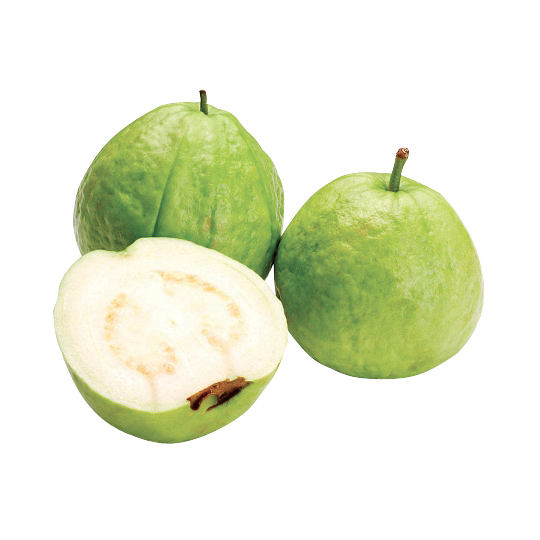
White Guava
Few would know that the Guava finds it origins in Central America and Mexico. Today of course the fruit has spread throughout the world, and right from Hawaii to India.
In India, White Guava is primarily produced in Andhra Pradesh, Tamil Nadu, Karnataka, Maharashtra and Uttar Pradesh. Allahabad Variety, produced in Allahabad, Uttar Pradesh, Is generally considered the best.
The fruit is included amongst super-fruits for health given rich base of health properties. A single guava contains four times the amount of Vitamin C as that in an orange.
- Specifications
- Standards
- Packaging
- Request a sample
Product Description
The product is derived from fresh, sound ripe, White Guava fruit (Psidium guajava Mytraceae VAR Pink & white). Firm fully matured Guavas are harvested, quickly transported to fruit processing plant and inspected. Fully ripened Guava fruits are then washed, deseeded, pulp extracted, centrifuged ( if required) thermally processed and aseptically filled by HTST process into pre-sterilized bags or in OTS cans which are hermetically sealed processed and cooled.
Organoleptical, Physical and Chemical Analysis
Appearance
Uniform, gritty, smooth, free from fibers and any foreign matter.
Aroma and Flavor
Characteristic prominent aroma of natural ripe Guava and free from any fermented & off flavor and free from scorched or caramelized flavor.
Taste
Characteristic typical sweet acidic taste of natural ripe Guava fruit. Free from any off taste.
Color
Appealing Ivory white to creamish white.
Physical Characteristics
Brix @ 20ºC: 9° Min
Acidity: 0.45 to 0.60 (As % anhydrous citric acid W/W)
pH @ 20ºC: 3.75 to 4.20
Consistency@ 20°C: 6 – 10 cm / 30 Sec (Bostwick)
Black Specks: < Nil
Brown Specks: < 10 no per 10 Gms.
Microbiological Standards
Total Plate Count: <10 CFU per gram.
Yeast and Mould Count: <10 CFU per gram
Coliform: Absent per gram
Pathogens: Absent per gram
“Commercially sterile”, free from bacillus, osomophilic yeast, coliform and any other pathogenic microorganism and fit for human consumption.
General standards
Product is free from added sugar, dyestuff, synthetic flavor, stabilizers, pesticides & herbicidal residues and radioactive contamination.
Quality Standards
‘Good Manufacturing Practices’ is applied in the manufacturing process to meet the laid down given standards as per HACCP by ISA Cert B.V Netherlands, SGF (SGF International E.V) and ISO – 9001 (AQA International).
Preservatives
Free from any chemical preservatives
Pesticide residues
In conformance with WHO recommendations & EC directives.
Packaging
Aseptic
Aseptic fruit purees are available in 210 kg bags in drum. Aseptic fruit purees are filled on US-FDA approved aseptic filler into pre-sterilized, high-barrier bags placed in steel drums internally painted with food grade lacquered and drum tightly closed to ensure no free space inside the drum.
OTS Cans
Canned fruit purees are available in A-10 size (3.1 =/- 2% kgs) and such 6 cans in one carton.
Loadability
Aseptic
80 drums per 20 ft container palletized or unpalletized.
Cans:
6 x 3.1kgs A-10 cans in one carton and 1000 cartons in 20 ft container.
Storage
Aseptic product:
It should be stored at cool & dry place below 15 °C preferably below 7 °C for retention of Ivory cream to whitish cream color intact. Guava fruit puree has a natural phenomenal tendency of color loss during the storage at higher temperature.
Canned product:
It should be stored at ambient temperature of ( 25° – 30°C).Guava fruit puree has a natural phenomenal tendency of color loss during the storage particularly after 6 months & above and further it deteriorate slowly as the storage period is extended.
Shelf life
12 months from the date of production under above mentioned storage conditions. The contents must be immediately used after opening the bag or can.
Custom products
Aseptic and canned fruit purees can also be supplied as per customer’s specification.